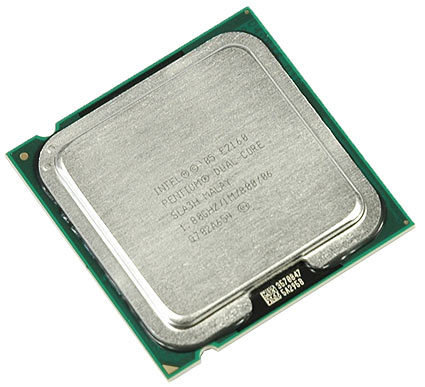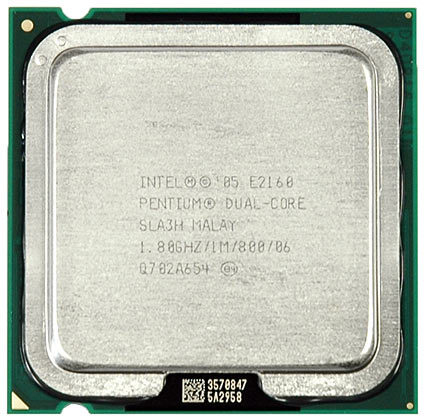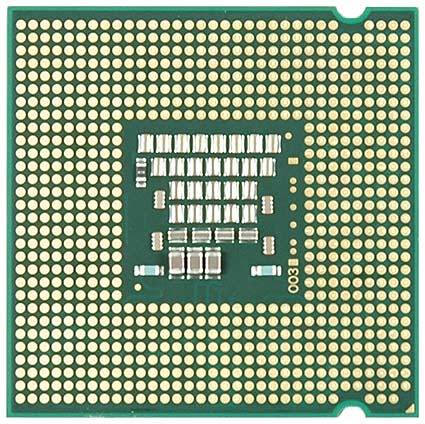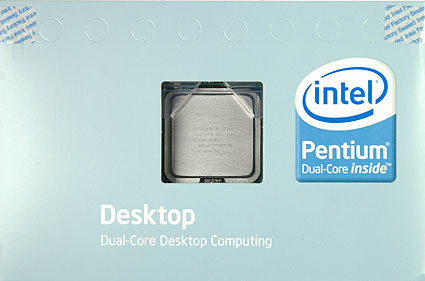$89 Pentium Dual Core that Runs at 3.2 GHz
Processor: Pentium Dual Core E2160
We already described most of the Pentium Dual Core facts in the intro and the second page of this article. The Pentium Dual Core E2000 family is available at three different stock speeds: the E2140 runs at 1.6 GHz, E2160 is the 1.8 GHz part and E2180 works at 2.0 GHz. All of them utilize a 200 MHz system clock (FSB800) and the Core 2 microarchitecture. When compared to Core 2 Duo with its 2 MB or 4 MB L2 cache, the Pentium Dual Core comes with only 1 MB, and it also doesn't support the virtualization technology called VT.
The three models currently cost approximately $79, $89 and $99. We doubt that the 2.0 GHz model overclocks better, because the Pentium Dual Core is nothing more than a Core 2 Duo with reduced L2 cache and clock speed due to having failed at certain tests. The third possibility, which would be Intel reducing the L2 cache size and clock speed to provide more low-cost processors requested by large customers, certainly is the best one for end users, because it implies that even clock speeds far beyond 3 GHz could still work...
We were able to run our E2160 retail processor at up to 3.3 GHz. However, the processor wasn't sufficiently stable at this speed, so we switched to 3.2 GHz for benchmarking. To reach this clock speed, we simply set the FSB speed to 355 MHz. As expected, we had to increase the core voltage from 1.325 V to 1.525 V. Applying more voltage (we tried 1.55 and 1.6 V) didn't lead to better overclocking results.
There is a nice advantage to accelerating the FSB speed within the capabilities of the motherboard, or only slightly beyond (355 instead of 333 MHz), which is the modest overclocking of the memory. The DDR2 RAM operated at DDR2-880 speed. Although it didn't cause any problems, we decided to increase the memory voltage anyway, just as a precaution.
The 3.2 GHz final clock speed represents an almost 80% overclocking over the base clock speed of 1.8 GHz. Since the 80% applies to both to the core clock and the FSB speed, it's difficult to say which is the actual bottleneck. We decided to sit back, relax, and watch the benchmarks. Complaining that an 80% overclock isn't enough for a $89 processor would be somewhat weird anyway!
Get Tom's Hardware's best news and in-depth reviews, straight to your inbox.
Current page: Processor: Pentium Dual Core E2160
Prev Page Test Motherboard: Gigabyte P35-DS3P Next Page Do Not Go For Similarly Priced Pentium 4 Or Pentium D CPUs
Patrick Schmid was the editor-in-chief for Tom's Hardware from 2005 to 2006. He wrote numerous articles on a wide range of hardware topics, including storage, CPUs, and system builds.
-
ripwind Yep - It was this very article that caused me to buy mine, along with a G92 8800GTS. My E2160 has been running @ 3.2GHZ with the stock cooler for almost 3.5 years. I'm only now considering an upgrade.Reply
Both that processor and that video card have scaled so well over the years that I'm still able to run what I want at 1920x1080 with reasonable settings. -
presto84 I've just bought a second hand motherboard for university and it came with this CPU onboard. Remembered this article so had to look to check it was the same chip. The board has an Intel P945 chipset and supports up to 1333mhz according to the website so might be worth giving this a go.Reply -
Noodletoe One of my all-time favorite Toms articles - used it to OC my E2180 to 3.0ghz 4 years ago and it's still running strong as my guest computer. I was just looking to upgrade the CPU to a E-6550 I found for cheap, but after re-reading this article I think I'll just leave it alone :)Reply



